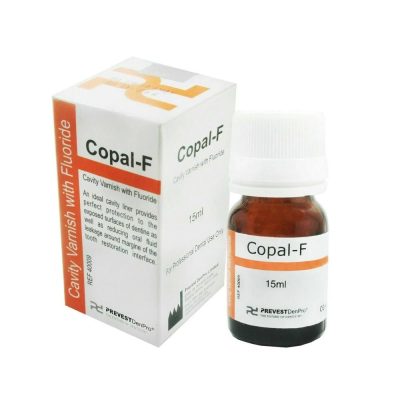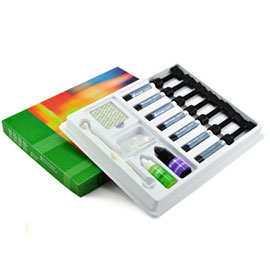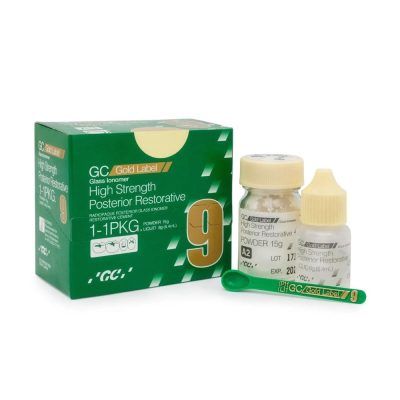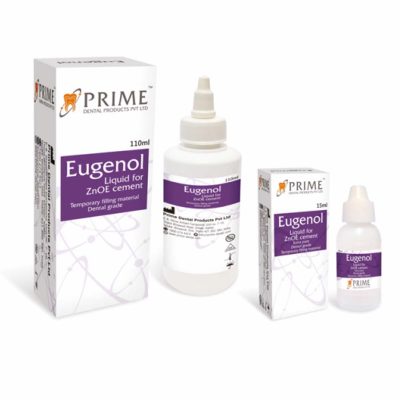| Directions To USE | 1. Removal of the temporary restoration and cleaning of the cavity
Remove any residue of the temporary luting cement from the cavity or preparation with a polishing brush and an oil and fluoride-free cleaning paste (e.g. fluoride-free Proxyt). Rinse with water spray. Subsequently, dry with air that is free of water and oil. Avoid overdrying.
Note: Cleaning with alcohol could lead to dehydration of dentin.
2. Try-in of the restoration and drying
Next, check the shade, fit and occlusion of the restoration. Care should be taken when checking the occlusion of fragile and brittle ceramic objects before they are permanently cemented, as there is a risk of fracture. If necessary, make adjustments with fine diamonds at medium speed and with slight pressure using copious amounts of water. Polish ground surfaces.When an adhesive luting protocol with composites is used, safe isolation of the operating field – preferably with a rubber dam, e.g. OptraDam, or alternatively with cotton rolls and a saliva ejector – is required. If the dental hard tissue is contaminated with blood or saliva during the tryin procedure, it must be cleaned again.
3. Pre-treatment of the restoration
After try-in, thoroughly rinse the restoration with water spray and dry it with oil-free air.
Completely coat the bonding surface of the restoration with Ivoclean using a microbrush or brush.
Allow Ivoclean to react for 20 seconds. Thoroughly rinse the restoration with water spray and dry it with oil-free air.
Use Monobond N on restorations made of lithium disilicate glassceramics or zirconium oxide ceramics (e.g. IPS e.max Press/CAD IPS e.max ZirCAD). Apply Monobond N to the cleaned surfaces using a brush or microbrush. Allow Monobond N to react for 60 seconds and subsequently disperse it with a strong stream of air
4. Mixing of Multilink N Primer A and Multilink N Primer B
The two primer liquids Multilink N Primer A and B are mixed in a 1:1 ratio (e.g. 1 drop Primer A and 1 drop Primer B). The mixed Primer A/B is solely self-curing and does not need to be protected against light. However, it must be applied within 10 minutes.
5. Application of the mixed Multilink N Primer A/B to the enamel and the dentin
Apply the mixed Multilink N Primer A/B onto the entire bonding surface using a microbrush, starting with the enamel surface, and scrub it in for 30 s. Disperse excess with blown air until the mobile liquid film is no longer visible. As the Primer is solely self-curing, no light-curing is necessary.
Note: Previous conditioning of enamel with phosphoric acid is required for Maryland bridges.
6. Application of Multilink N to the restoration
For each application, place a new automix tip on the syringe. Dispense Multilink N from the automix syringe and apply the desired amount onto the restoration. As the luting material will cure in the used mixing tip, it serves as a seal for the remaining contents of the syringe until needed again (replace with a new tip before the next use).
Note: Multilink N should be used quickly after it has been dispensed and the restoration should be placed rapidly! Multilink N is applied directly to the inner surface of the restoration. The application of Multilink N directly to the preparation or the cavity, which has been pre-treated with Multilink N Primer, is not indicated as this would lead to considerable acceleration of the curing process and thus may compromise the fit of the restoration
7. Placement of the restoration and removal of excess cement
solely self-curing
Seat the restoration in place and secure it. Remove excess material immediately with a microbrush/brush/foam pellet/dental floss or scaler. Remove excess rapidly in difficult-to-reach areas (proximal areas, gingival margins, pontics). Due to the reaction between Multilink N and Multilink N Primer A/B, a high bond strength and a high degree of cure is achieved within a few minutes of seating the restoration.
self-curing with additional light-curing (quarter technique, indicated for cases with up to 2 bridge abutments = 3 to 4-unit bridges)
Light-curing of all excess cement and subsequent removal: Seat the restoration in place and secure it. Light-cure excess cement in quarter segments (mesio-oral, disto-oral, mesio-buccal, disto-buccal) using a polymerization light at a distance of max. 10 mm.
self-curing with additional light-curing (quarter technique, indicated for cases with up to 6 bridge abutments = circular bridges)
Light-curing of all excess cement and subsequent removal: Seat the restoration in place and secure it. Successively light-cure excess cement on all the abutments in quarter segments (mesio-oral, disto-oral, mesio-buccal,disto-buccal) using a polymerization light at a distance of max. 10 mm.
Thereafter, excess cement is easy to remove with a scaler. Excess must be removed rapidly in difficult-to-reach areas (proximal areas, gingival margins, pontics). Subsequently, light-cure all the margins again for 20 s (approx. 1,000 mW/cm2, e.g. Bluephase in HIGH POWER mode or Bluephase Style).
Note: Like all composites, Multilink N is subject to oxygen inhibition: In other words, the surface layer (approx. 100 µm) does not polymerize during the curing process, as it comes in contact with atmospheric oxygen. In order to avoid this, we recommend covering the restoration margins with glycerine gel/air block (e.g. Liquid Strip) immediately after the removal of excess. After complete polymerization, the glycerine gel/air block is rinsed off with water.
8. Finishing of the restoration
Finish the cement joints with preparation diamonds if necessary.
Polish restoration margins/cement joints with suitable polishers (e.g. Astropol ) as well as finishing and polishing strips.
Check occlusion and function and make adjustments if necessary |
|---|








